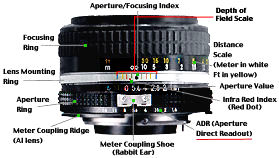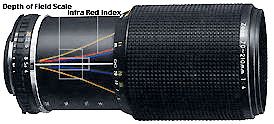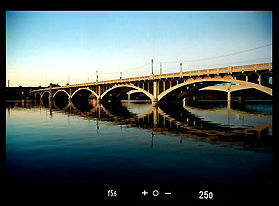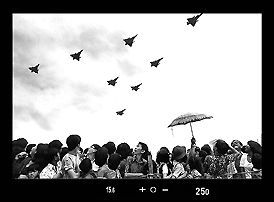As most Nikkor lenses
are operated at full aperture for ease of focusing, visualization of the depth of
field at the shooting aperture may be difficult. Thus, the camera's depth-of-field
preview button often can come in handy.
 |
The depth-of-fleld preview button lets you check (or "preview") the zone of sharpness at any time before (or after) shooting. Simply by depressing the button, the lens is stopped down to the preselected aperture to allow you to see how much background and foreground is in or out of focus. |
Note: The depth of field preview button is also used in stopped down Exposure Measurement in many of the manual focus Nikon SLRs.
Depth-of-Field Indicators
Depth of field can be read directly from the distance scale in meters or feet with
the aid of the color-coded depth-of-fleld indicators engraved on the lens barrel.
Each pair of colored lines on either side of the central distance scale index line
corresponds to f/numbers of the same color on the aperture scale.
 |
 |
|
| For example, f/16 on the aperture ring of the 50 mm f/1.4 lens is blue. With the lens prefocused at 17 feet (5 m), the numbers on the distance scale opposite the blue lines show that the depth of field extends from 9 feet (2.7 m) to infinity (OO). | ||
To find the depth of field at a particular aperture, first focus the lens on the subject while looking through the viewfinder. Then check the numbers on the distance scale to determine the zone of focus for the aperture in use. (Check Here for an Illustration)
The exposure meter of
the F2AS Photomic finder utilizes Nikon's through-the-lens center-weighted exposure
measurement at full aperture.
 |
The meter reads the light over the entire focusing screen but favors the central 12mm-diameter area, while taking the entire area into consideration. This allows you to make precise readings of the selected subject area, and results in more balanced overall exposures. |
Determining
Exposure
The finder has three LED exposure indicators visible within the view field ("+" for overexposure, "O" for correct exposure, and
"-" for underexposure); thus,
the metering system is capable of providing easy-to-read exposure information in
five steps, and even at extremely low-light levels. Additionally, the selected shutter
speed and lens aperture settings are visible for maximum ease of operation for setting
the desired exposure.
To determine the correct exposure with the Nikon F2AS: Switch ON the meter by moving the film-advance lever to the 20° standoff position; with this action, one of the LED indicators will light, indicating overexposure, correct exposure or underexposure. If the plus (+) indicator lights, increase the shutter speed or decrease the aperture until the center (°) indicator just comes on and the (+) turns off; if the minus ( - ) indicator is lit, decrease the shutter speed or increase the aperture until the center indicator lights. |
When two LEDs light simultaneously (i.e., "+" and a, or "-" and "O"), the exposure setting is within 1- stop of correct exposure; thus, be sure to adjust the aperture setting slowly to get only the correct "center" exposure.
The amount of light reaching the film plane is determined by a combination of the lens aperture and the shutter speed. Since the two are interrelated, different combinations will give the same exposure. A 1-step change in the shutter speed, or a 1-stop change in the aperture setting, will either halve or double the exposure.
When two LED's light simultaneously (i.e., + and o, or - and o), the exposure setting is within 1-stop of correct exposure; thus, be sure to adjust the aperture setting slowly to get only the correct "center" (o) exposure.
For example, a shutter speed of 1/125 second passes twice as much light as a setting of 1/250 second, and only half as much light as a speed of 1/60 second; for an aperture setting of f/11, twice as much light as f/16, and half as much as f/8, is passed. This feature characterizes the operation throughout the available range of shutter speeds and aperture settings. With this in mind, it's easy to see that if a correct exposure for a scene is 1/125 at f/11, then 1/60 at f/16 or 1/250 at f/8 will be equally acceptable.
The best combination for your needs will depend on the results desired. Use fast shutter speeds to freeze motion, or use slow speeds to produce deliberate and creative blur. Small apertures give greater depth of field, while large apertures restrict sharp focus to the main subject. The creative selection of both speeds and apertures will greatly enhance your photography. |
Example:
| Shutter speed (sec.) |
1/2000 |
1/1000 |
1/500 |
1/250 |
1/125 |
| Aperture (f/number) |
4 |
5.6 |
8 |
11 |
16 |
More
info
is available at a | separate
section
| on the topic "Exposure"
and its relation to Shutter Speed and Aperture.
Metering Range
If the center "correct exposure" LED fails to illuminate, even after all
possible lens-aperture/shutter-speed combinations have been tried, then the available
light is too bright or too dim for the meter's range. To correct this situation,
several measures may be taken, as follows: Switch to a new film (either higher or
lower ASA) that more closely matches the available light; mount a neutral density
filter on the lens to decrease the light reaching the film plane; or use artificial
lighting (i.e., an electronic flash unit) to increase subject illumination. Remember,
too, that the lens in use can greatly influence suitability for bright or dim shooting.
For example, a 50mm f/1.4 lens (with ASA 100 film) couples from EV - 2 (f/1.4 at
8 seconds) to EV 17 (f/8 at 1/2000 second) for excellent low-light performance; on
the other hand, a 200mm f/4 lens proves more usable at bright-light levels, coupling
(with ASA 100 film) from EV 1 (f/4 at 8 seconds) to EV 20 (f/22 at 1/2000). Thus,
choose the lens carefully to match the existing lighting conditions.
| Previous | NEXT | 5 / 11 Low-Light Metering, Time Exposures, Eyepiece Shutter, High-Contrast scenes, Stopped-Down Exposure Measurement, Exposure Compensation Adjustment
| Back | Main Index Page of Nikon F2AS
| Message Board | for
your favourite Nikon
F2 Series SLR model(s)
| Message Board | for your Nikon Optics in a shared environment
| Message Board | Specifically for Dispose or Looking for Nikon/Nikkor Photographic
Equipment
| Back |
to Main
Index Page of Nikon
F2 Series SLR models
| Back | Main Index Page of
Pictorial History of Nikon SLRs
 |
The Eyes of Nikon:- |
Fisheye-Nikkor Lenses - Circular | Full Frame | Ultrawides Lenses - 13mm15mm18mm20mm | Wideangle Lenses - 24mm28mm35mm |
Standard Lenses - 45mm 50mm 58mm | Telephoto Lenses - 85mm105mm135mm180mm & 200mm |
Super-Telephoto Lenses - 300mm 400mm 500mm 600mm 800mm 1200mm |
Special Application lenses:
Micro-Nikkor Lenses - 50mm~55mm -60mm 85mm -105mm 200mm Micro-Zoom 70-180mm
Perspective Control (PC) - 28mm 35mm PC-Micro 85mm
Dedicated Lenses for Nikon F3AF: AF 80mm f/2.8 | AF 200mm f/3.5 EDIF
Depth of Field Control (DC): 105mm 135mm
Medical Nikkor: 120mm 200mm
Reflex-Nikkor Lenses - 500mm 1000mm 2000mm
Others: Noct Nikkor | OP-Nikkor | UV Nikkor 55mm 105mm | Focusing Units | Bellows-Nikkor 105mm 135mm
Nikon Series E Lenses: 28mm35mm50mm100mm135mm | E-Series Zoom lenses: 36~72mm75~150mm70~210mm
MF Zoom-Nikkor Lenses: 25~50mm | 28~45mm | 28~50mm | 28~85mm | 35~70mm | 36~72mm E | 35~85mm | 35~105mm | 35~135mm |
35~200mm | 43~86mm | 50~135mm | 50~300mm | 70~210mm E | 75~150mm E | 80~200mm | 85~250mm |
100~300mm | 180~600mm | 200~400mm | 200~600mm | 360~1200mm | 1200~1700mm
Tele-Converters: TC-1 | TC-2 | TC-200 | TC-201 | TC-300 | TC-301 | TC-14 | TC-14A | TC-14B | TC-14C | TC-14E | TC-16 | TC-16A | TC-20E
![]()
Nikon F
| Nikon F2 |
Nikon
F3
| Nikon F4 |
Nikon
F5
| Nikon F6 |
Nikkormat / Nikomat |
Nikon FM
| Nikon FE/ FA | Nikon EM/FG/FG20 | Nikon Digital SLRs | Nikon - Other models
MIR Supports for Photographic Community: Various Message Boards/Community
Forums
Nikon
F-series|
Nikon
F2-series|
Nikon
F3-series|
Nikon F4-series| Nikon
F5-series|Nikkormat/Nikomat-series
Nikon FM-series|Nikon
FE-series|Nikon
FA|Nikon
Digital
SLR
series|Various
Nikon
Models|Nikkor
Optic
-shared
Others:- Free Trade Zone - Photography| Free Trade Zone - Business Community |Free To Zouk - Photographic Community
Apple's Mac Public Community Message Board | Windows based PC &
Apple/Mac
Public Community Trade Exchange Centre
Recommended links to understand
more technical details related to the Nikkor F-mount and production Serial Number:
http://rick_oleson.tripod.com/index-153.html by: my friend, Rick Oleson
http://www.zi.ku.dk/personal/lhhansen/photo/fmount.htm by: Hansen, Lars Holst
http://www.mir.com.my/rb/photography/hardwares/nikonfmount/lens2.htm
http://www.photosynthesis.co.nz/nikon/serialno.html
About this photographic site.
HOME - Photography in Malaysia |
Copyright © 2000. leofoo ®. MIR Web Development Team.
In
memory of my friend Com.
Augusto Staut,
Brazil, 1971-2000.
Credit: Chuck Hester, US for his patience, encouragement
and help to setup the various content in this site; Robert Johnson for some of his original
images on the F2H-MD appeared in this site; my ex-staff, KiaSu for his superb
3-D logo appeared in this Nikon F2 site; Marc Vorgers from Holland who
generously provide me with some of his images of F2AS; MCLau®, who has so much time with me to
re-edit the content in this site and not to mention buying a Nikon Coolpix 990 just
for this site. Keat Photo,
Kuala Lumpur for providing
their Nikon F2A to take some images for this site; again, Mr Edward Ngoh the
great camera collector who provides us his collection of F2AS with MD-2; hawkeye.photographic.com
for their images on the Speed Magny film backs; Sean Cranor for his image
on Nikon F2 25th Anniversary Model; Ted Wengelaar®, Holland for his continuous
flow of input on some of the early Nikon bodies; CYLeow ® , photo editor of the Star
newspaper, Malaysia for some of his images used in this site. Ms Rissa Chan, Sales manager from
Shriro Malaysia who has helped to provide some of the very useful input. HiuraShinsaku®,
Nikomat ML, Japan for some of his images on various F2 models; my staff, Wati, Maisa, Mai and my nephew, EEWyn®, who volunteered and helping me
did so many of the film scanning works. Contributing photographers or resellers:
Jen Siow, Foo KokKin, Arthur Teng, Mark Fallander, John
Ishii, Ed Hassel, YoonKi Kim, Jean-Louis, M.Dugentas (Dell Corner.com.), Mr "Arsenall" and a few images mailed
in from surfers with no appropriate reference to their origin. Dedicated to KU Yeo, just to express our mutual regrets over the outcome of
a recent corporate event. Made with a PowerMac, broadcast with a Redhat Linux powered server.
![]()
![]()

